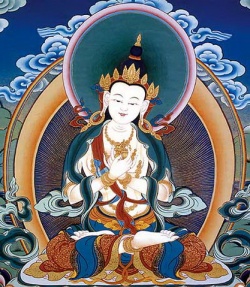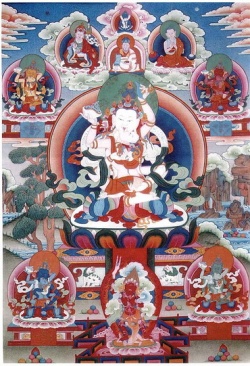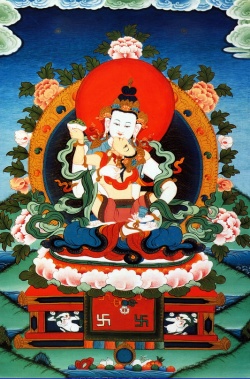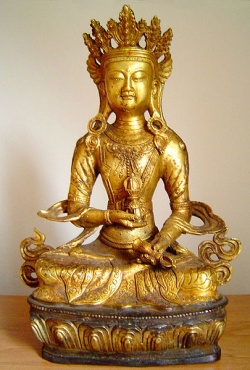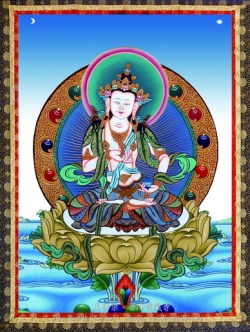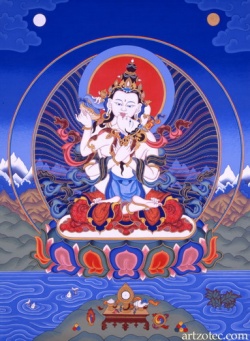Vajrasattva tantra by Vladimir Montlevich
How wonderful is this Vajrasattv a ! B. D. Dandaron's quotation
The name Vajrasattva is known to all who have read Buddhist tantric texts or got the right on the so-called preparatory practices.
Vajrasattva meditation is recommended for those who strive towards practical Buddhism . Deriving from that, one can often hear the wide-spread opinion that this persona in the Buddhist pantheon of deities ends up being only the means for cleaning spirituality at the beginning of the Way. However, this is by far not true and the term and place of Vajrasattva in Buddhist hierarchy is far more ambiguous, but this is not understood at first sight.
The etymology of the name “Vajrasattva ” is the following: Vajrasatva - in Sanskrit letter-by-letter “Diamond strong i.e. theoretically and practically unbreakable being; sattva - being. If vajra symbolizes the fact that it is unbreakable (not controlled by samsaric effects), then Vajrasattva is the embodiment of unbreakability of a being in its most exquisite and high form, it is like a being that has consciousness. Therefore the principle it presents and symbolizes, that characterizes Vajrasatva , can be summarized with the sentence: “Imperishable consciousness.”
In wider terms this has been explained in “Hevajra tantra ”:
- “So I have heard. Once Bhagavat was in the glory with Vajrayogins who are the nature of body, speech and thought of all Tathagatas. Then Bhagavat uttered the following words: “highly honoured body, speech and thought of all Tathagatas , more secret than any other secret. O Vajragarbha , the mahasattva -bodhisattva of supreme compassion. Thanks to the truth, thanks! Obey to and follow the one who is called Vajrasattva, Mahasattva, Mahasamayasattva and Hridaya Hevajra! ”
Vajragarbha asked: “Why Vajrasattva? How come then Mahasattva ? And for what Samayasattva ? Would you not explain to me Bhagavat ?”
Bhagavat said: “Vajra is the name because the one is unbreakable; sattva - because it unites three forms; the creator of force as such is called Vajrasattva . He is filled with great aroma of wisdom and therefore called Mahasattva . As he always abides his vow or oath his name is Samayasattva .”
Vajragarbha asked: “How should one understand his name? What is this Hevajra ? What does the syllable “He” mean and what does “Vajra” mean?”
Bhagavat answered: “He” speaks of great compassion; “Vajra ” of intuition. Listen to the nature of tantric method and intuition presented by me.”
Hevajra tantra starts with such explanation. He (Vajrasattva ) is the original source of all those tantra texts. The name Vajrasattva is presented here as the first name, personified reality, then the names of his qualities follow and finally the name which is common for the given tantra - Hridaya Hevajra .
Similar is the characterization of Vajrasattva in sadhana , which has been dedicated to him in Krija-tantra “Seventeen Vajrasattva deities" (bCom-ldan-'das dang la rDo-rje-sems-dpa lha bcu-bdun-gyi sgrub-thabs rab dkar bdud-rtsi'i chu-rgyun shes bya-ba-bzhugs) in the part “Vajra blessing and drilbu”: “The syllable HUM gives birth to vajra ; then appears the Vajrasattva , white by colour, holding a vajra and a drilbu , which while floating transforms into vajra . Being without a beginning and an end - this is Vajrasattva , of great joy, of all-encompassing goodness, the nature of all, the governor and husband of Dorje Nima Karma, Highest most glorious Winner, the one who was born first.”
(Translation from Tibetan by S. E. Korotkova)
Here also Vajrasattva has been called the “first.” Additionally his quality is all-encompassing goodness, which makes him equal to Samantabhadra . He (Vajrasattva) is also a “Winner,” which has been used as an epithet of Buddha through ages. In such way Vajrasattva becomes the direct “first” emanation of the Highest Buddha.
Such is his meaning in the old Nyingmapa tradition :
- The central figure of Vajrayana is bodhisattva Vajrasattva. He personifies dharmakaya (Tib. chos-sku) deriving from Spheres of Pure Reality with Rupakaya, which consists of sambhogakaya and nirmanakaya.
In later tradition nyingma i.e. the old tradition is compared to the so-called later traditions - Sakya , Kagyu and Gelug - in such tantras as Kalacakra , Cakrasamvara and Vajrabhaivara (the main tantras of Gelug tradition ) the visualization of Vajrasattva pre-purification practice is directly followed by shelter vow, bodhisattva vow and the Four Immortals .
The method itself seems a bit artificial in the middle of a block of text, like imported from the outside. It is explained by the fact that Vajrasattva tantras are of far older descent than the tantras used in new traditions .
It is clear that Vajrasattva is far older when compared to the Guhyasamaja tantra . Researches in the field of buddhology have determined the creation time of Guhyasamaja tantra , which is dated back to the 3rd century AD.
Kalacakra did not make its appearance until the 10th century. The rest of the tantras were finally systematically compiled in India not before the 7th century. Therefore the significant role of Vajrasattva tantra, which was written down 1st century AD, in the early phase of the history of Buddhism , is not surprising.
The existence of Vajrasattva in the category of earlier tantric texts and anuttra-tantras is supported by the fact that according to tradition namely Vajrasattva declared the teachings of Krija-tantra , which belongs among External Tantras .
The formation of known tantras can nowadays be categorized as follows:
- Tantras , which are particularly linked to the name of Vajrasattva , appeared not before the 5th century AD - Cakrasamvara tantra, Vajrabhaivara tantra in the 7th century and finally Kalacakra tantra in the 10th century. This timeline is only a hypothesis and it will probably be edited a number of times as the time passes.
The early creation of Vajrasattva tantra is covered by the story of the legendary king Indrabodhi . According to the tantric tradition Indrabodhi came to the world 28 years after the existence of Buddha in parinirvana . From bodhisattva Vajrapani he got the root-text of mahayoga Guhyagarbha-tantra the so-called magic tradition Gyutul (sGyu-'phrul).
This was made possible after seven continuous dreams. According to another version 18 mahayoga texts or books fell from the sky. At first Indrabodhi did not understand the text of Guhyagarbha-tantra and was forced to go to mahasiddha Kukuraja to get explanations.
By visualizing Vajrasattva he understood the meaning and explained what he saw to raja. Kukuraja told the king to visualise Vajrasattva and the king visualized so carefully that he completely identified the nature of Vajrasattva to himself. Thanks to such text visualization Indrabodhi, who understood the nature of tantra, became Enlightened. After that he gave the acquired knowledge to Kukuraja , who reached the same level. Indrabodhi is usually located on the first place in the sequence or descent line and Kukuraja only after him. Kukuraja was the first known practicer of Vajrasattva and that was long before Garab Dorje. Regarding the formation of teachings linked to the name Vajrasattva there is a theory offered by the Nyingma tradition taking place in the area of Lake Dhanakoša where Garab Dorje was born and promoted the teachings. Gilgita and the mountains of that area served as a protection from religious elide in conflict with government in the neighbouring kingdoms.
Namely mountain settlements of Uddiyana , which were protected from social disruptions and effects through centuries, were a kind of interesting seedbed where tantra practices were polished, edited and co-ordinated with Mahayana theories. The sphere of these teachings can be expanded geographically if we originate from caravan routes of those days like the special status of Silk Road. Caravan routes united areas like West-Turkistan , the southern part of [[Wikipedia:Central Asia|Central Asia]] , Cashmere and Northern-Afghanistan into one big spiritual-cultural whole. Uddiyana is located exactly at the crossing point of the mentioned areas.
The role of Vajrasattva in old Nyingma tradition is especially notable. Nyingma divides tantras into external and internal. Internal tantras represent the contents of old school teachings and consist of two traditions: the Tradition of Transmitting (Tib. rgyud-sde) and the practice Tradition of Immersing and Introspection (Tib. sgrub-sde). These are corresponded by nine lines of implementation, first three of which correspond to the Tradition of Transmitting the Teachings:
- Tantra about the Teachings of the Victorious or Tradition of all-encompassing Buddha Thinking (Tib. rgyal-ba dgongs-brgyud) - Samantabhadra, on the level of dharmakaya .
- Tantra about the signal of the keeper of the mantra or Vidyadhara tradition (Tib. rig-dzin-brda-brgyud) - from Garab Dorje, sambhogakaya level.
- Tantra of Whispers or Karnatantra (Rechung-pa distributed the teachings of Karnatantra).
The tradition of Oral Transmission (Tib. gang-zag-snyan-brgyud) - from Vajrasattva and five Dhyani Buddhas.
In Karnatantra we find:
O governor Vajrasattva in whose eyes all are equal - the vajra knowing all dharmas in a castle on the field of Akanistha, who has reached his own consciousness. You - located high above - are an extremely grandiose deity. You - deity, who has formed from consciousness, are free of conditioning and causality. Show me the higher states of consciousness!
Once such prayer had been uttered, the five honoured ones said: The formation of Buddhas from consciousness has never been taught before, will not be tough now or ever in the future. Therefore they made an announcement of quitting and without teaching anything descended into silence.
Not announcing signifies Big Announcement (14).
This wonderful section mentions the main quality of a Vajrasattva: consciousness of yidam, not the knowledge of the existence of a dry fact, which is personified by Vairocana, but knowledge of the self as the separated one and the person who has the form of all-encompassing existence.
Vajrasattva is presented as the prototype of a human-being, as an unerring matrix, along which the predictable drama of inseparable existence, endless variants and diversity develops - not like us, beings with stained souls and "sinful" conductors of samsara. The extraction process of Vajrasattva as a perfect programme is two-folded - built along five senses and five families of Dhyani Buddhas.
Actually the main creative yi dam is the most important for Vajrasattva nyingma tradition but in later practice the first place is occupied by Vajrakilaya.
The name of Vajrasattva in Nyingmapa is inseparably linked to Garab Dorje and he is considered the first human personification of Vajrasattva - that is the first nirmanakaya form of Vajrasattva - from whom he got the texts and the teachings of dzogchen in the form of 6 million 400 thousand verses.
Vajrasattva is also honoured as the spiritual mediator between dharmakaya and sambhogakaya. In such context he transmitted the main part of first three Internal Nyingma Tantras (mahayoga), which consisted of 18 tantras , to Vajrapani. He gave the teachings to humans starting from older Indrabodhi, king of Zahor and the tradition is continued like that even nowadays.
But in general terms we are used to talking about 18 mahayoga tantras as independently, spontaneously created from Dharmadhatu, which does not have a source or cause. The last words belong to Tarthang Tulku Rinpoche and quite accurately illustrate the characterization of the Traditions, which are linked to Vajrasattva.
Independence, timelessness, anthropomorphism, which is without a beginning and an end -> such is the nature of Vajrasattva as a yi-dam, which personifies the principle of imperishability.
The information about Vajrasattva present in Mahayoga is expressed in 18 tantras , which belong to Guhyagarbha tantra (in Sanskrit Shri-guhyagarbha-tattva-vinishcaya, Tibetan dPal-gsang-ba’i-snying-po de-kho-na-nyid rnam-par nges-pa)20, which represents the so-called Magical tradition or Gjutul' (Tibetan sGyu-phrul dra-ba, Sanskrit Mayajala - Magical net).
Guhyagarbha also contains the description of the mandala Hundred Deities of Vajrasattva where there are 42 peaceful and 58 wrathful deities. According to the opinion of two modern Nyingmapa lamas Khenpo Palden Šerab and Khenpo Tsevan Dongyal the Guhyagarbha tantra is the root text of Vajrasattva and Mahayoga tradition.
Guhyagarbha - it is the basis for both anuyoga and atiyoga. Such opinion is in accordance with the viewpoint of Tartang Tulku Rinpoche that Vajrasattvamayajala tantras , which were translated into Tibetan in the 8th century by Vimalamitra and Janakumara, were compiled namely on the basis of the Guhyagarbha text.
According to another authority, modern Nyingma lama Trinley Norbu, the mahayoga tantra part contains four texts, including Vajrasattva Maiajala, which in turn consists of eight texts the first of which is Guhyagarbha.
Trinley Norbu's Guhyagarbha tradition originates from Vajrasattvamayajala tantra.The root tantra of Vajrasattva is mainly Vajrasattvamayajala tantra.
The tantras named in much later modifications, which are used in Gelug tradition - Bhagavat Shri Vajrasattva or deity realisation method or the so-called Endless Flow of White Nectar (Tib bCom-ldan-das dPal rDo-rje-sems-dp’a lha bcu-bdun gyi sgrub-thabs rad dkar bdud-rtsi’i chu rgyun zhes-bya-ba bzhugs) - are known as Dandaron's tradition, Seventeen Deities of Vajrasattva by a shorter name.
The form of this text is similar to Guhyagarbha’s complex two-part structure. However, a minimal Vajrasattva mandala consists of all five Dhyani Buddhas and in the final stage one still only visualises Vajrasattva.
One way or another Vajrasattva is the yi dam in the texts of Tibetan school of Buddhism , which also proves its much earlier formation when compared to the new tantras of anuttrayoga category.
The appearance of Vajrasattva is always human-like - there are no extra heads, hands or feet, no wings, flames or smoke. He is the etalon of perfect human body, the harmony of emotions and the mind. The appearance of Vajrasattva is the iconographic continuation of Buddha in his mahayana development - like Vidjadhara clothing (clothes of bodhisattvas ), which is common for the clothing of the beings of sambhogakaya sphere. At the peak of its development (1st century BC until not later than 3rd century AD) the teaching of Vajrasattva was main and comprehensive in Mahayana texts.
He kept his position in Nyingma where his practice cannot by any means called preparatory as Vajrasattva is and will be the main yi dam with the help of whom complete enlightenment is achieved.
Here is a typical example from the life of Nyingma yogi Zurchung Sherab Trakpa (1014-1074), which ascertains the importance of Vajrasattva tantra in Nyingma tradition:
He rose to the mountain once again, settled down there without paying any attention to supernatural phenomena and focused.
At the location of Vajrasattva he practiced Vajrasattva sadhana “Method of dhyani and mudra", which originates from Guhya and Mayajala (Tib rSang-ba sGyu-phrul-las byung-ba’I phyang-rgya bsam-gtan-gyi sgrub-pa). He acquired the visualisation and intuition of Vajrasattva. Vajrasattva filled the entire valley with himself. And in the perceived vision (Tib snang-bzang-bar-gyi skye-mched) of all external objects, which only have form like water, fire etc he clearly understood that all belongs to the visualization of Vajrsattva.
In other modern Tibetan schools of Buddhism the visualization of Vajrasattva has exceptionally been taken to the level of preparatory practices, which fulfil the main task - cleaning our minds of stains. Vows are broken easily but the visualization of Vajrsattva has the force of cleaning and restoring those vows. For that reason it has to be practiced together with other tantric visualizations.
The more natural and significant is the renaissance of the teaching of Vajrasattva in the tradition of B. D. Dandaron. Here he is the main yi dam of the tradition together with Vajrabhaivara. Whereby sadhana with Vajrasattva text, which Dandaron gave to his students with dedication, including the phases of attaining perfection (Sanskrit sampannakrama; Tibetan rdzog-rim) with the system of chakras based on three channels missing in popular texts. Dandaron had got this tradition from his Guru, who visualized in the cave of Tjan-Ljan for 26 years. With regard to the eradication of the teachings in Russia in the 20th century Dandaron’s declaration was unprecedented and wonderful. Spontaneous by nature, like deriving from dharmadhatu itself, according to Vajrasattva style - filled with deep knowledge. Therefore Dandaron’s students called the Teacher’s declaration “a gift from above”, regardless of the existence or a lack of continuous line of heritage. In 1973, already located at the Vordino prison camp, Dandaron gave to his students even more expanded method of Vajrasattva visualization, which thereafter carries the name of Vordin's dubtab (sadhana ).
In addition to the purification stage common to all tantras Dandaron’s dubtab of Vordin also includes the second stage of visualization, which contains a much deeper visualization of Vajrasattva. At this stage the yogi visualizes himself as Vajrasattva, the mantra spinning around the syllable HUM signifying heart. The syllables excreting from the central channel of the yogi as light and nectar are helpful to all being in samsara.
In Dandaron’s case this phase is signified unconventionally when compared to the Vajrasattva sadhana spread in Tibet. The special elements of this method stand in signifying the elements of the implemented phase - dzogrim, pranayama and dummo practice.
Dandaron thought that one visualization is enough for implementing enlightenment and also recommended it for attaining vajra-like good health. Additionally, Vajrasattva as a subject of Guru-yoga was considered the best means for expanding the relationship between a teacher and a student. During his last year of life (1971-1972) Dandaron repeatedly spoke about the wish of building a Vajrasattva temple, which should have been white and round according to his ideas. The importance of Vajrasattva for Dandaron was expressed in his phrase: "How wonderful is this Vajrasattva!"
The visualization of Vajrasattva can be expressed by different methods. If one visualizes Vajrasattva in everyday life we can watch the practice as four continuous blessings. At that the hundred-syllable mantra has to be said at least seven times for every blessing. The first - vase blessing purifies the body and acts as a seed for the appearing seven forms of nirmanakaya. Yogi‘s body is filled with nectar, cleaning it of physical dirt, which excretes from the bottom part of the body.
The second - secret blessing purifies speech and gives the ability of attaining ideal body - sambhogakaya. Light and nectar fill the mind and rise upwards excreting the stains of speech from upper cavities.
The third - blessing of wisdom, which frees from spiritual limitedness for attaining the Body of Complete Truth - dharmakaya.
Nectar fills the body and destroys arrogance dissolving the latter as a black egg near the heart turning it into a crystal vase filled with Dharmakaya nature.
The fourth - blessing of declaration removes all stains of body, speech and mind simultaneously. It creates the conditions of attaining svabhavikaya through one’s individual nature. Although we write about different phases of visualization, it may take place simultaneously or separately part by part.
In canonical texts, during the final phase of visualization, Vajrasattva turns to the one practicing: Your sins are disgusting and all your violations of vows I will purify and remove! Once said so (the visualizing person) delves into me and my three doors become inseparable from the Body, Speech and Thought of Vajrasattva. In the dubtat of Vodrin this term is corresponded by the following words: Momentarily I will turn into Vajrasattva. Then the following happens... There is a syllable on the heart, which plays bindu (Tib thig-le), which is corresponded by a far more subtle form of consciousness - citta (Tib sems de) and type of energy - vaju (Tib rlung).
In body speech and thought Vajrasattva dissolves into you. While sensing this moment one has to try to stay in it as long as possible by declaring to oneself that all existing and happening is sunyata.
It is almost impossible to talk about heart bindu, it has to be experienced. And still: in this heart bindu there is nothing - no ideas, no creativity, no wisdom. There are no fortunes, there is nothing. It is empty and this emptiness is not sunyata. Discovering this emptiness is a sign of experiencing dharmakaya: dharmakaya-yoga.
Heart bindu symbolizes the nature of akaasha, all channels, which divide in the bindu sphere originate from it. It contains the endless perfection of the noble nirmanakaya and sambhogakaya. Trikaya in every moment - One and two bodies, there is no escape from it, And not hundred, and not thousand moments, but existence is always on that side of the border between two emptinesses.
Border, Open horizon, akasha metrics, there is nothing else, but it is everything, always, here. According to Dandaron’s , and not only his, tradition of Vajrasattva visualization, the visualization ends with addressing the teachers: Give us the two highest siddhis! With that they do not want a siddhi, which goes through walls, hears from long distances etc - they want to see the Teacher as Vajrasattva.
Seeing is the highest perception method of senses. Knowing and understanding is to see the thought figure - most of us think geometrically.
“Signifying speech as a means of communication is only common for human beings.” T. V. Brjancjukovi (1939-1999)
Therefore the two most important qualities of a human being: one - the oldest and the most primal and common to all living - vision; and the other - visualization, which is the highest religious practice honoured in prayers, which according to Dandaron's tradition concludes the practice of Vajrasattva visualization. In modern Western Buddhism the Vajrasattva tantra is primary and according to sadhana from the shortest up to the 100-syllable vajrasattva mantra. The easier variants of practices are preferred. Without any doubt Vajrasattva will become the personification ideal morality.
The initial variant of Vodrin’s dubtat was shorter and later comments were added. Dandaron started learning the initial stage during the Second World War and visualization in mandala starting from 1965 when students from the European side appeared. Dubtat of Vodrin was written in 1973 at Vodrin’s prison camp, which is located on the southern shore of Lake Baikal where Dandaron was sent after court in 1972. The text was made public by B. Dugarov and thereafter immediately implemented by the students.
Source
Author: Vladimir Montlevich
budcon.com

